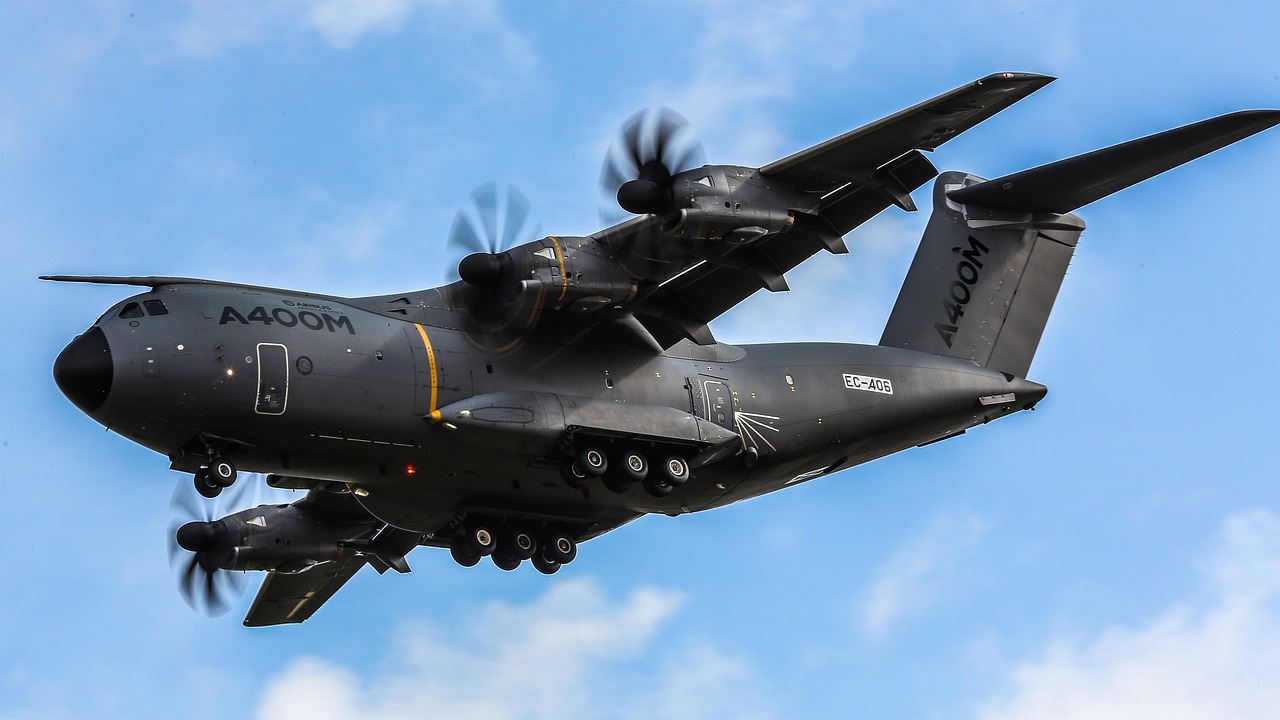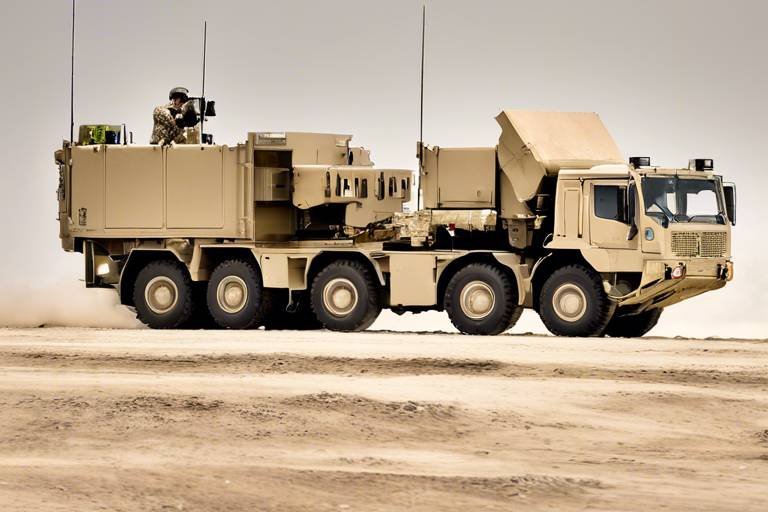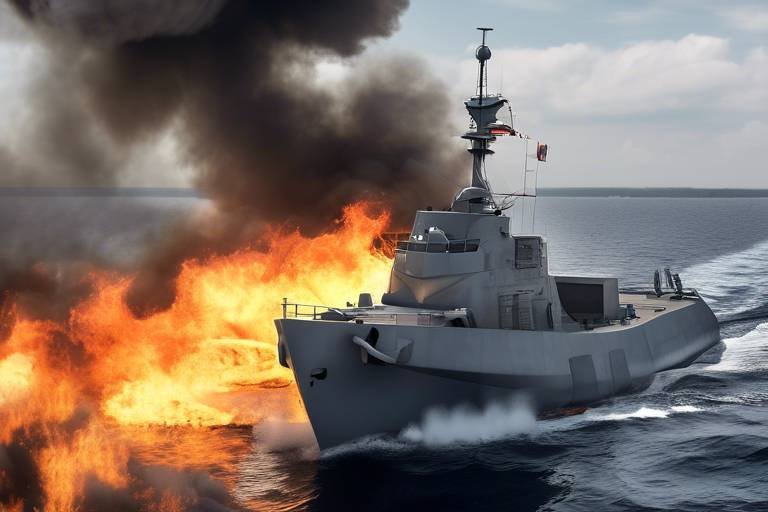How the UGVs Are Enhancing Ground Troop Capabilities
In today's fast-paced and ever-evolving battlefield, Unmanned Ground Vehicles (UGVs) are revolutionizing the way military operations are conducted. Imagine a world where soldiers can focus on strategic decision-making while robots handle the dangerous and monotonous tasks. That's precisely what UGVs bring to the table! These remarkable machines are not just a technological marvel; they are vital assets that enhance the capabilities of ground troops in numerous ways. From increasing the safety of soldiers to optimizing logistical operations, UGVs are paving the way for a new era of military efficiency.
The integration of UGVs into military operations is akin to adding a powerful tool to a craftsman's toolkit. Just as a skilled carpenter wouldn't rely solely on a hammer, modern military forces are leveraging UGVs to tackle various challenges on the battlefield. These vehicles are equipped with cutting-edge technology, allowing them to perform tasks ranging from reconnaissance to supply transport. With their ability to operate in hazardous environments, UGVs significantly reduce the risks faced by human soldiers, making them invaluable in combat scenarios.
One of the most compelling aspects of UGVs is their enhanced situational awareness. These vehicles are outfitted with advanced sensors and cameras that provide real-time data and imagery from the battlefield. This capability is crucial for commanders who need to make informed decisions quickly. Imagine being able to see the battlefield from multiple angles without putting troops in harm's way! This level of intelligence gathering enables military leaders to strategize effectively, ensuring that every move is calculated and precise.
Furthermore, UGVs play a pivotal role in logistical support. In many operations, the success of a mission hinges on the timely delivery of supplies and equipment. UGVs can transport everything from ammunition to medical supplies, ensuring that troops have what they need when they need it. This not only enhances operational efficiency but also mitigates supply chain vulnerabilities that can arise in hostile environments. The ability to resupply units without risking human lives is a game-changer in modern warfare.
However, while the advantages of UGVs are clear, it's essential to acknowledge that they are not without their challenges. The military must address various technical limitations and ensure that these vehicles are reliable in diverse environments. For instance, operating UGVs in rugged terrains or extreme weather conditions can pose significant hurdles. This necessitates ongoing innovation and development to enhance their capabilities further.
As we move forward, the collaboration between UGVs and other unmanned systems, such as Unmanned Aerial Vehicles (UAVs), will create a comprehensive surveillance network that maximizes operational effectiveness. This synergy allows for improved intelligence gathering and operational coordination, ultimately leading to more successful missions. The future of ground troop capabilities is undeniably intertwined with the evolution of UGV technology, and we are just beginning to scratch the surface of its potential.
- What are Unmanned Ground Vehicles (UGVs)?
UGVs are robotic vehicles that operate on the ground without a human driver. They are used in military operations for various tasks, including surveillance, logistics, and combat support. - How do UGVs enhance troop safety?
By taking on dangerous tasks such as reconnaissance and supply transport, UGVs significantly reduce the risk to human soldiers, allowing them to focus on strategic operations. - What challenges do UGVs face?
UGVs encounter challenges such as technical limitations, vulnerability to cyberattacks, and performance issues in diverse terrains and environmental conditions. - How do UGVs work with UAVs?
UGVs and UAVs can work together to create a comprehensive surveillance network, improving intelligence gathering and operational coordination on the battlefield.

The Evolution of UGV Technology
The journey of Unmanned Ground Vehicles (UGVs) is nothing short of fascinating, showcasing a remarkable evolution that has transformed military operations. It all began in the early 20th century when the concept of unmanned vehicles was just a flicker of an idea. Fast forward to today, and we see UGVs that are not only capable of traversing challenging terrains but are also equipped with cutting-edge technology that enhances their functionality. This evolution is a testament to human ingenuity and the relentless pursuit of improving military capabilities.
Initially, UGVs were rudimentary prototypes, often resembling remote-controlled cars. These early models were primarily used for reconnaissance missions, providing a glimpse into enemy positions without putting soldiers at risk. However, as technology advanced, so did the complexity and capabilities of these vehicles. The introduction of advanced sensors, cameras, and artificial intelligence has enabled UGVs to perform intricate tasks that were once thought impossible.
One of the most significant milestones in UGV development came with the integration of GPS technology and sophisticated navigation systems. This allowed UGVs to operate autonomously, navigating through diverse environments while avoiding obstacles in real-time. Imagine a vehicle that can make decisions on the fly, adapting to its surroundings just like a human would. This leap in technology has not only increased the operational effectiveness of UGVs but has also significantly reduced the risk to human soldiers.
Furthermore, the evolution of UGVs has been marked by their ability to work in tandem with other unmanned systems, such as Unmanned Aerial Vehicles (UAVs). This integration creates a multi-dimensional approach to battlefield operations, where UGVs handle ground tasks while UAVs provide aerial support. The synergy between these systems enhances situational awareness and operational coordination, making military missions more efficient and effective.
As we look to the future, the evolution of UGV technology shows no signs of slowing down. Ongoing research and development are focused on enhancing their capabilities even further. For instance, advancements in materials science are leading to the creation of lighter yet more durable vehicles, while improvements in battery technology promise longer operational times. The potential for UGVs to incorporate machine learning and data analytics is also on the horizon, enabling them to learn from their experiences and improve their performance over time.
In summary, the evolution of UGV technology reflects a continuous journey of innovation, driven by the need for enhanced military capabilities. From their humble beginnings to the sophisticated systems we see today, UGVs have become an indispensable asset on the modern battlefield. Their ability to adapt and evolve will undoubtedly play a crucial role in shaping the future of military operations.
- What are UGVs used for? UGVs are primarily used for reconnaissance, surveillance, logistical support, and even combat operations in military contexts.
- How do UGVs communicate with operators? UGVs typically use secure communication channels, including radio frequencies and satellite links, to relay information and receive commands from operators.
- Can UGVs operate autonomously? Yes, many UGVs are equipped with advanced navigation systems that allow them to operate autonomously in various environments.
- What are the main challenges facing UGVs? Some challenges include technical limitations, cybersecurity threats, and environmental conditions that can hinder their performance.

Key Advantages of UGVs in Combat
The integration of Unmanned Ground Vehicles (UGVs) into modern military operations has revolutionized the way combat is conducted. These advanced machines are not just tools; they are game-changers that bring a multitude of benefits to the battlefield. Imagine a world where soldiers can focus on strategic decisions while robots handle the dangerous tasks—this is the reality that UGVs are creating. One of the most significant advantages is the increased situational awareness they provide. Equipped with cutting-edge sensors and cameras, UGVs can gather real-time data, allowing commanders to make informed decisions swiftly. This capability is crucial in fast-paced combat scenarios where every second counts.
Moreover, UGVs significantly reduce the risk to human soldiers. By deploying these vehicles in high-risk areas, military forces can protect their personnel from potential threats. For instance, when clearing a minefield or scouting enemy positions, UGVs can take the lead, minimizing the exposure of soldiers to life-threatening situations. This protective measure not only saves lives but also boosts the morale of ground troops, knowing that they have reliable support behind them.
Another key advantage of UGVs lies in their logistical support capabilities. In any military operation, the timely delivery of supplies and equipment is vital for success. UGVs can transport essential materials directly to troops in the field, ensuring they have what they need to perform their missions effectively. This capability is especially important in remote or hostile environments where traditional supply routes may be compromised. By utilizing UGVs for resupply missions, military forces can enhance their operational efficiency and reduce vulnerabilities within their supply chains.
Furthermore, UGVs excel in data collection and analysis. As they traverse the battlefield, these vehicles gather critical information that can be analyzed to improve strategic planning. For example, UGVs can monitor troop movements, assess enemy positions, and even detect potential threats before they become a danger. The data collected can be shared with command centers, providing a comprehensive overview of the battlefield and enabling more effective resource allocation. This not only enhances operational effectiveness but also contributes to overall mission success.
In summary, the advantages of UGVs in combat are numerous and impactful. From enhanced situational awareness to logistical support and data analysis, these unmanned vehicles are reshaping the future of military operations. As technology continues to evolve, we can only expect UGVs to become even more integral to ground troop capabilities.
- What are UGVs? Unmanned Ground Vehicles (UGVs) are robotic vehicles designed to operate on the ground without a human operator onboard. They are used in various military applications, including reconnaissance, logistics, and combat support.
- How do UGVs improve soldier safety? By taking on dangerous tasks, such as scouting and transporting supplies in high-risk areas, UGVs significantly reduce the exposure of human soldiers to potential threats.
- What types of sensors do UGVs use? UGVs are equipped with a variety of sensors, including cameras, thermal imaging, and radar, which allow them to gather real-time data and enhance situational awareness on the battlefield.
- Can UGVs operate in all terrains? While UGVs are designed to navigate various terrains, their performance can be affected by environmental conditions. Continuous innovation is necessary to improve their capabilities in challenging landscapes.

Enhanced Surveillance Capabilities
In the ever-evolving landscape of modern warfare, Unmanned Ground Vehicles (UGVs) have emerged as pivotal assets, particularly in the realm of surveillance. Imagine a battlefield where every movement, every sound, and every potential threat can be monitored in real-time without putting a single soldier in harm's way. This is the reality that UGVs bring to military operations today. Equipped with an array of advanced sensors and cameras, these robotic vehicles offer unparalleled situational awareness, allowing commanders to make informed decisions swiftly and effectively.
The integration of sophisticated technologies into UGVs has significantly enhanced their surveillance capabilities. For instance, many UGVs are outfitted with high-definition cameras, thermal imaging systems, and even radar, enabling them to gather critical intelligence day or night, regardless of weather conditions. This multi-faceted approach to data collection not only improves real-time awareness but also aids in post-mission analysis. In fact, the data collected can be invaluable in shaping future strategies and operational planning.
Moreover, UGVs can operate in environments that are too dangerous or inaccessible for human soldiers. They can traverse challenging terrains, from urban settings to rugged landscapes, all while capturing vital information. This capability is especially crucial in reconnaissance missions where understanding the enemy's position and movements can mean the difference between success and failure.
To further illustrate the impact of UGVs on surveillance, consider the following benefits:
- Real-time Data Transmission: UGVs can transmit data back to command centers instantaneously, ensuring that decision-makers have up-to-the-minute information at their fingertips.
- Reduced Human Risk: By deploying UGVs for surveillance, military forces can minimize the risk of casualties, allowing human troops to focus on more strategic roles.
- Comprehensive Coverage: With the ability to operate across different terrains and conditions, UGVs can cover vast areas, providing a broader picture of the battlefield.
Furthermore, the collaboration between UGVs and Unmanned Aerial Vehicles (UAVs) creates a synergistic effect that enhances overall operational capabilities. When these two platforms work together, they form a comprehensive surveillance network that significantly improves intelligence gathering and operational coordination. For example, while a UAV conducts aerial surveillance, a UGV can be deployed on the ground to investigate specific points of interest, providing a layered approach to battlefield awareness.
In conclusion, the enhanced surveillance capabilities of UGVs are transforming how military operations are conducted. By leveraging advanced technologies and integrating with other unmanned systems, these vehicles not only improve situational awareness but also contribute to the overall success of missions. As we look to the future, the continued evolution of UGV technology promises even greater advancements in surveillance, ensuring that military forces remain one step ahead of their adversaries.
- What are UGVs? Unmanned Ground Vehicles (UGVs) are robotic systems designed to operate on the ground without a human operator on board, often used in military operations for reconnaissance, surveillance, and logistical support.
- How do UGVs enhance surveillance? UGVs enhance surveillance by utilizing advanced sensors and cameras to gather real-time data, allowing military commanders to make informed decisions and improve situational awareness on the battlefield.
- Can UGVs operate in all terrains? While UGVs are designed to traverse various terrains, their performance can be affected by extreme environmental conditions, which is an area of ongoing innovation and development.
- How do UGVs work with UAVs? UGVs and UAVs can work together to create a comprehensive surveillance network, where UAVs provide aerial views while UGVs gather ground-level intelligence, enhancing overall mission effectiveness.

Integration with UAVs
The integration of Unmanned Ground Vehicles (UGVs) with Unmanned Aerial Vehicles (UAVs) marks a significant leap forward in military strategy and operational effectiveness. Imagine a dynamic duo where ground and air assets work in perfect harmony, creating a comprehensive surveillance network that enhances situational awareness and operational coordination. This synergy allows military forces to gather intelligence from multiple perspectives, leading to more informed decision-making on the battlefield.
By combining the strengths of UGVs and UAVs, military operations can achieve a level of efficiency previously thought unattainable. For instance, while UGVs maneuver through rugged terrains, UAVs soar above, providing a bird's-eye view of the battlefield. This dual approach ensures that commanders have access to real-time data, enabling them to respond swiftly to changing conditions. As a result, the integration of these technologies not only improves situational awareness but also enhances the overall safety of ground troops.
Furthermore, UGVs equipped with advanced sensors and cameras can relay critical information back to UAVs, which can then analyze and disseminate this data to command centers. This real-time data exchange creates a feedback loop that significantly enhances operational capabilities. For example, if a UGV detects an enemy position, it can immediately notify a UAV to conduct aerial reconnaissance, confirming the threat before troops are deployed. This proactive approach minimizes risks and maximizes effectiveness.
Moreover, the integration of UGVs and UAVs also facilitates improved communication and coordination among different units. With the ability to share data seamlessly, ground and air units can operate as a cohesive force rather than as isolated entities. This not only streamlines operations but also fosters a more agile response to emerging threats.
In summary, the integration of UGVs with UAVs is revolutionizing military operations by enhancing surveillance, improving data collection, and fostering better communication. As technology continues to evolve, we can expect even more sophisticated systems that will further blur the lines between ground and aerial combat capabilities, ultimately leading to greater success on the battlefield.
- What are UGVs and UAVs?
UGVs are Unmanned Ground Vehicles designed for ground operations, while UAVs are Unmanned Aerial Vehicles used for aerial surveillance and reconnaissance. - How do UGVs and UAVs work together?
They collaborate by sharing real-time data and intelligence, enhancing situational awareness and operational effectiveness. - What are the benefits of integrating UGVs and UAVs?
The integration improves safety for troops, enhances data collection, and allows for more efficient military operations. - Are there challenges in integrating UGVs and UAVs?
Yes, challenges include technical limitations, cybersecurity threats, and the need for robust maintenance and support systems.

Data Collection and Analysis
In the fast-paced and unpredictable environment of modern warfare, the ability to collect and analyze data in real-time can be the difference between success and failure. Unmanned Ground Vehicles (UGVs) are at the forefront of this data revolution, acting as mobile sensors that gather crucial information from the battlefield. Imagine a UGV as a diligent scout, tirelessly traversing hostile terrain, capturing everything from troop movements to environmental conditions, and relaying that information back to command centers. This capability not only enhances situational awareness but also informs strategic planning and decision-making.
One of the most significant advantages of UGVs is their ability to operate in dangerous areas where human soldiers would be at risk. Equipped with an array of sensors—including cameras, thermal imaging, and even chemical detection systems—UGVs can collect data that would otherwise be too risky to obtain. For instance, during reconnaissance missions, these vehicles can provide real-time video feeds that help commanders assess enemy positions and movements without exposing personnel to danger.
Furthermore, the data collected by UGVs can be analyzed using advanced algorithms and artificial intelligence (AI) tools. This integration of technology allows for rapid processing of vast amounts of information, identifying patterns and trends that may not be immediately apparent to human analysts. Consider this: a UGV might gather thousands of data points in a single mission. By employing AI, military strategists can quickly sift through this data to extract actionable insights, enabling them to make informed decisions that could turn the tide of battle.
To illustrate the impact of UGVs on data collection, consider the following table that summarizes key data types collected by these vehicles:
| Data Type | Description | Use Case |
|---|---|---|
| Video Surveillance | Real-time video feeds from the battlefield | Assessing enemy positions |
| Environmental Data | Information about terrain and weather conditions | Planning routes for troop movement |
| Troop Movement Tracking | Monitoring the movements of friendly and enemy forces | Strategic planning and engagement |
| Logistical Data | Information on supply levels and resource allocation | Optimizing supply chains |
As the military continues to leverage UGV technology, the importance of data collection and analysis will only grow. The insights gained from UGV operations not only enhance immediate tactical decisions but also contribute to long-term strategic planning. By continuously feeding data into military databases, UGVs help create a comprehensive picture of the battlefield, allowing for better resource allocation and mission planning.
In summary, the role of UGVs in data collection and analysis is transformative. They act as the eyes and ears of ground troops, providing critical information that enhances operational effectiveness. As technology progresses, we can expect even more sophisticated data-gathering capabilities from these unmanned vehicles, further solidifying their place in modern military operations.
- What are UGVs? Unmanned Ground Vehicles (UGVs) are robotic vehicles that can operate on the ground without a human operator on board. They are used for various military applications, including reconnaissance, logistics, and surveillance.
- How do UGVs collect data? UGVs are equipped with various sensors, including cameras and environmental sensors, that allow them to gather data in real-time while traversing the battlefield.
- What is the significance of data analysis in military operations? Data analysis helps military commanders make informed decisions based on real-time information, improving situational awareness and operational effectiveness.
- Are UGVs vulnerable to cyberattacks? Yes, like any connected technology, UGVs can be susceptible to cyber threats, making cybersecurity a critical aspect of their deployment.

Logistical Support and Resupply
In the high-stakes world of military operations, logistical support and resupply are the lifeblood that keeps ground troops operational. Imagine a battlefield where supplies are as critical as ammunition; without them, missions can falter, and lives can be jeopardized. This is where Unmanned Ground Vehicles (UGVs) shine, acting as the unsung heroes of logistical support. By transporting essential supplies, equipment, and even medical aid to troops in remote or hostile locations, UGVs enhance operational efficiency in ways that were previously unimaginable.
One of the most impressive aspects of UGVs is their ability to navigate challenging terrains that would be perilous for human-operated vehicles. Whether it’s rocky mountains, sandy deserts, or muddy fields, these robotic vehicles can traverse various environments with ease, ensuring that vital resources reach the front lines when they are needed most. This capability not only boosts the speed of resupply but also significantly reduces the risk to human life, as soldiers no longer need to venture into dangerous areas to deliver supplies.
Moreover, UGVs are equipped with sophisticated navigation systems and sensors, allowing them to operate autonomously or semi-autonomously. This means they can deliver supplies based on real-time data, adapting their routes to avoid threats or obstacles. For instance, if enemy activity is detected in one area, a UGV can quickly reroute to deliver supplies through a safer path, ensuring that troops remain well-equipped without exposing them to unnecessary danger.
Another compelling advantage of UGVs in logistical operations is their ability to carry a substantial payload. Depending on the model, a UGV can transport everything from food and water to ammunition and medical supplies. This capability not only streamlines the supply chain but also allows for efficient resource allocation. For example, a UGV can make multiple trips in a single day, significantly increasing the volume of supplies delivered compared to traditional methods. This ensures that troops remain well-stocked, which is crucial for maintaining morale and operational readiness.
As military operations evolve, so too does the technology behind UGVs. Innovations such as autonomous refueling stations and advanced communication systems are being developed to further enhance their logistical capabilities. These advancements will enable UGVs to operate for extended periods without the need for human intervention, making them even more indispensable on the battlefield.
However, it’s essential to recognize that while UGVs offer remarkable advantages in logistical support, they also require a robust support system to ensure their reliability. Maintenance, software updates, and operator training are crucial components that military organizations must consider to maximize the effectiveness of these vehicles. As the technology continues to advance, the military must also invest in the infrastructure needed to support these innovations.
In conclusion, UGVs are revolutionizing the way military logistics are conducted. By improving the speed and safety of resupply missions, they are not only enhancing operational efficiency but also saving lives. As technology continues to evolve, the role of UGVs in logistical support will only become more prominent, paving the way for a future where ground troops can operate with unprecedented effectiveness and safety.
- What are Unmanned Ground Vehicles (UGVs)?
UGVs are robotic vehicles designed to operate on the ground without a human operator on board. They are used in various military and civilian applications, including logistics, surveillance, and combat support. - How do UGVs improve logistical support?
UGVs enhance logistical support by transporting supplies to troops in challenging terrains, reducing the risk to human soldiers, and increasing the speed and efficiency of resupply operations. - What are some challenges faced by UGVs?
Challenges include technical limitations, vulnerability to cyberattacks, and the need for effective maintenance and support systems to ensure reliability.

Challenges and Limitations of UGV Implementation
The implementation of Unmanned Ground Vehicles (UGVs) in military operations, while revolutionary, is not without its challenges. These challenges can significantly impact the effectiveness and reliability of UGVs on the battlefield. One major concern is the technical limitations that UGVs face. Despite the advancements in technology, UGVs can struggle with complex terrains and unexpected environmental conditions. For instance, while some UGVs are designed to navigate rugged landscapes, others may falter in urban settings where obstacles abound. This inconsistency can lead to operational delays and increased risk for ground troops who may rely on these vehicles for support.
Another pressing issue is the vulnerability to cyberattacks. As UGVs become more interconnected and reliant on data communication, they also become prime targets for adversaries looking to disrupt military operations. Hackers could potentially take control of a UGV or manipulate its data, leading to catastrophic consequences. This emphasizes the necessity for robust cybersecurity measures to protect communication channels and sensitive data. Without adequate protection, the very technology designed to enhance troop capabilities could become a liability.
Moreover, the maintenance and support systems required to keep UGVs operational can be extensive. Regular maintenance is crucial to ensure that these vehicles function correctly, especially in high-stakes environments. If a UGV malfunctions during a critical mission, it could jeopardize the safety of the troops it is meant to assist. As such, military forces must invest in comprehensive training and support systems to maintain UGV fleets effectively. This investment, while necessary, can strain resources and complicate logistics.
Additionally, the integration of UGVs into existing military operations presents its own set of challenges. For example, training personnel to operate and maintain UGVs requires time and resources that could be allocated elsewhere. Furthermore, there is often a learning curve associated with adopting new technologies, which can temporarily hinder operational efficiency. It’s essential for military leaders to weigh these factors carefully when considering the deployment of UGVs.
In conclusion, while UGVs offer numerous advantages that can transform military operations, their implementation is fraught with challenges that need to be addressed. From technical limitations and cybersecurity threats to maintenance demands and integration hurdles, military forces must navigate these obstacles to fully realize the potential of UGV technology. As they continue to evolve, ongoing innovation and strategic planning will be key to overcoming these limitations and enhancing the effectiveness of ground troops.
- What are the main advantages of using UGVs in military operations? UGVs enhance situational awareness, reduce risks to human soldiers, and improve logistical support.
- How do UGVs contribute to surveillance? They are equipped with advanced sensors and cameras that provide real-time data, helping military personnel make informed decisions.
- What cybersecurity measures are necessary for UGVs? Securing communication channels and protecting sensitive data from cyber threats are critical to maintaining the integrity of UGV operations.
- Can UGVs operate in all types of terrain? No, UGVs have varying capabilities and may struggle in certain terrains or environmental conditions, highlighting the need for ongoing innovation.

Cybersecurity Concerns
As we dive deeper into the era of advanced technology, surrounding Unmanned Ground Vehicles (UGVs) have escalated significantly. Just imagine this: a highly sophisticated robotic vehicle, designed to assist troops in perilous situations, suddenly becomes a target for cyberattacks. This scenario is not far-fetched; it’s a potential reality that military strategists must grapple with. The integration of UGVs into military operations brings forth a myriad of challenges, especially in the realm of cybersecurity.
One of the most pressing issues is the vulnerability of UGVs to hacking attempts. These vehicles rely heavily on communication networks to receive commands and transmit data back to their operators. If these channels are not adequately secured, adversaries could intercept or manipulate the information being exchanged. This could lead to catastrophic failures on the battlefield, where the stakes are incredibly high. To put it simply, if a hacker can take control of a UGV, they could turn it into a weapon against its own forces.
Moreover, the data collected by UGVs is often sensitive and critical for mission success. This information must be protected from unauthorized access and potential leaks. A breach could not only compromise ongoing operations but also provide adversaries with valuable insights into military strategies and capabilities. Therefore, ensuring robust cybersecurity measures is essential for maintaining operational integrity.
To mitigate these risks, military organizations are investing in advanced encryption techniques and secure communication protocols. However, the evolving nature of cyber threats means that what works today may not be sufficient tomorrow. Continuous updates and enhancements to cybersecurity measures are necessary to stay one step ahead of potential threats. Here’s a quick overview of some key strategies being employed:
- Encryption: Utilizing strong encryption methods to secure data transmission.
- Regular Software Updates: Keeping UGV software up-to-date to patch vulnerabilities.
- Access Control: Implementing strict access controls to limit who can interact with UGV systems.
In addition to these strategies, training personnel to recognize and respond to cyber threats is equally crucial. A well-informed team can be the first line of defense against potential attacks. As UGV technology continues to evolve, so must the approaches to securing these systems. The goal is to create a resilient framework capable of withstanding the ever-changing landscape of cyber warfare.
In conclusion, while UGVs offer unparalleled advantages in modern military operations, their cybersecurity concerns cannot be overlooked. As we push the boundaries of technology, we must also fortify our defenses against those who seek to exploit these advancements for malicious purposes. The future of military operations may very well depend on our ability to secure the very tools that enhance our capabilities.
- What are UGVs? Unmanned Ground Vehicles (UGVs) are robotic systems designed to operate on the ground without human operators on board, often used in military applications for reconnaissance, logistics, and combat support.
- How do UGVs enhance troop safety? UGVs can perform high-risk tasks, reducing the need for human soldiers to enter dangerous environments, thus minimizing casualties.
- What are the main cybersecurity threats to UGVs? The primary threats include hacking, data interception, and unauthorized access to communication networks, which can lead to operational failures or misuse of the vehicles.
- What measures are taken to secure UGVs? Military organizations implement encryption, regular software updates, and strict access controls to protect UGV systems from cyber threats.

Terrain and Environmental Limitations
The deployment of Unmanned Ground Vehicles (UGVs) has revolutionized military operations, but they are not without their challenges. One significant hurdle is the that can hinder their effectiveness. Imagine trying to navigate a high-tech vehicle through a rugged mountain range or a dense forest—it's not as easy as it sounds. UGVs are designed to traverse various landscapes, but the reality is that certain terrains can pose serious obstacles.
For instance, rocky terrains can lead to mechanical failures or mobility issues. UGVs may struggle to maintain traction on steep inclines or uneven surfaces, which can limit their operational range. Additionally, soft or muddy ground can cause these vehicles to become bogged down, rendering them immobile. In extreme weather conditions, such as heavy rain or snow, UGVs may face further challenges, including reduced visibility and compromised sensor functionality.
Moreover, environmental factors like temperature extremes can affect battery life and overall performance. UGVs operating in extremely hot or cold climates may experience overheating or freezing issues, which can severely limit their operational capabilities. For military planners, understanding these limitations is crucial. They must consider the environmental conditions of the deployment area to ensure the successful integration of UGVs into their operations.
To address these challenges, ongoing research and development are essential. Engineers and military strategists are continually working to enhance the adaptability of UGVs. Innovations such as advanced suspension systems, improved sensor technology, and robust materials are being tested to ensure that these vehicles can withstand the rigors of various terrains. The goal is to create UGVs that are not only functional but also reliable in the most challenging environments.
Ultimately, while UGVs offer tremendous potential for enhancing ground troop capabilities, their success will depend on overcoming these terrain and environmental limitations. By investing in technology and understanding the intricacies of different landscapes, the military can maximize the effectiveness of these unmanned systems, ensuring they serve as valuable assets on the battlefield.
- What are UGVs? Unmanned Ground Vehicles (UGVs) are robotic vehicles designed to operate on the ground without human operators on board, often used in military applications.
- What are the main advantages of using UGVs in military operations? UGVs enhance situational awareness, reduce risks to human soldiers, and improve logistical support among other benefits.
- What challenges do UGVs face in combat? UGVs face challenges such as terrain limitations, environmental factors, and cybersecurity threats.
- How are UGVs being improved to handle difficult terrains? Ongoing research focuses on advancements in suspension systems, sensor technology, and materials to make UGVs more adaptable to various environments.
Frequently Asked Questions
- What are Unmanned Ground Vehicles (UGVs)?
Unmanned Ground Vehicles (UGVs) are robotic systems designed to operate on the ground without a human operator on board. They are equipped with advanced technology to perform various military tasks, enhancing the capabilities of ground troops.
- How do UGVs enhance troop safety?
UGVs reduce the risk to human soldiers by taking on dangerous tasks such as reconnaissance and logistics in hostile environments. By sending UGVs into potentially hazardous situations, troops can remain at a safer distance, thereby increasing overall mission safety.
- What advantages do UGVs offer in combat scenarios?
UGVs provide several key advantages, including enhanced situational awareness through real-time surveillance, improved logistical support for transporting supplies, and the ability to gather and analyze battlefield data, which aids in strategic decision-making.
- Can UGVs work alongside Unmanned Aerial Vehicles (UAVs)?
Absolutely! UGVs can operate in conjunction with UAVs to create a comprehensive surveillance network. This integration allows for improved intelligence gathering and operational coordination, making military operations more effective.
- What challenges do UGVs face in military operations?
UGVs encounter various challenges, such as technical limitations, vulnerability to cyberattacks, and the need for robust maintenance. These factors can affect their reliability and effectiveness in the field.
- How do cybersecurity threats impact UGVs?
Cybersecurity is a significant concern for UGVs as they rely on secure communication channels to transmit data. Protecting these channels from adversaries is crucial to ensure the safety and effectiveness of UGV operations.
- Are UGVs effective in all terrains?
No, UGV effectiveness can be impacted by various terrains and environmental conditions. Some UGVs may struggle in rough or unpredictable landscapes, highlighting the need for ongoing innovation and development to enhance their capabilities.



















